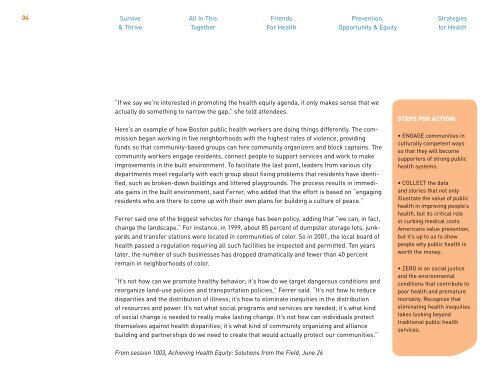INSIGHT & INSPIRATION FROM APHA’S 2012 MIDYEAR MEETING
INSIGHT & INSPIRATION FROM APHA’S 2012 MIDYEAR MEETING
INSIGHT & INSPIRATION FROM APHA’S 2012 MIDYEAR MEETING
Create successful ePaper yourself
Turn your PDF publications into a flip-book with our unique Google optimized e-Paper software.
34<br />
Survive All In This Friends Prevention, Strategies<br />
& Thrive Together For Health Opportunity & Equity for Health<br />
“If we say we’re interested in promoting the health equity agenda, it only makes sense that we<br />
actually do something to narrow the gap,” she told attendees.<br />
Here’s an example of how Boston public health workers are doing things differently. The commission<br />
began working in five neighborhoods with the highest rates of violence, providing<br />
funds so that community-based groups can hire community organizers and block captains. The<br />
community workers engage residents, connect people to support services and work to make<br />
improvements in the built environment. To facilitate the last point, leaders from various city<br />
departments meet regularly with each group about fixing problems that residents have identified,<br />
such as broken-down buildings and littered playgrounds. The process results in immediate<br />
gains in the built environment, said Ferrer, who added that the effort is based on “engaging<br />
residents who are there to come up with their own plans for building a culture of peace.”<br />
Ferrer said one of the biggest vehicles for change has been policy, adding that “we can, in fact,<br />
change the landscape.” For instance, in 1999, about 85 percent of dumpster storage lots, junkyards<br />
and transfer stations were located in communities of color. So in 2001, the local board of<br />
health passed a regulation requiring all such facilities be inspected and permitted. Ten years<br />
later, the number of such businesses has dropped dramatically and fewer than 40 percent<br />
remain in neighborhoods of color.<br />
“It’s not how can we promote healthy behavior; it’s how do we target dangerous conditions and<br />
reorganize land-use policies and transportation policies,” Ferrer said. “It’s not how to reduce<br />
disparities and the distribution of illness; it’s how to eliminate inequities in the distribution<br />
of resources and power. It’s not what social programs and services are needed; it’s what kind<br />
of social change is needed to really make lasting change. It’s not how can individuals protect<br />
themselves against health disparities; it’s what kind of community organizing and alliance<br />
building and partnerships do we need to create that would actually protect our communities.”<br />
From session 1003, Achieving Health Equity: Solutions from the Field, June 26<br />
STEPS FOR ACTION:<br />
• ENGAGE communities in<br />
culturally competent ways<br />
so that they will become<br />
supporters of strong public<br />
health systems.<br />
• COLLECT the data<br />
and stories that not only<br />
illustrate the value of public<br />
health in improving people’s<br />
health, but its critical role<br />
in curbing medical costs.<br />
Americans value prevention,<br />
but it’s up to us to show<br />
people why public health is<br />
worth the money.<br />
• ZERO in on social justice<br />
and the environmental<br />
conditions that contribute to<br />
poor health and premature<br />
mortality. Recognize that<br />
eliminating health inequities<br />
takes looking beyond<br />
traditional public health<br />
services.



